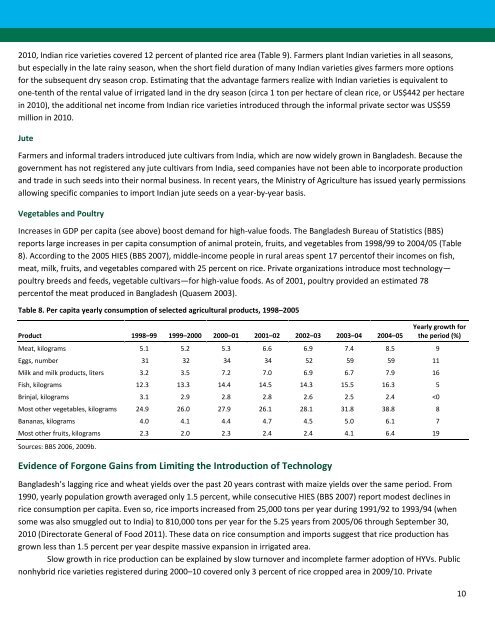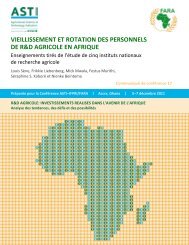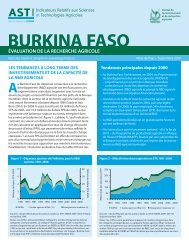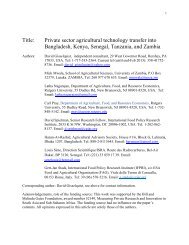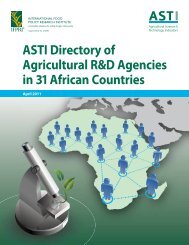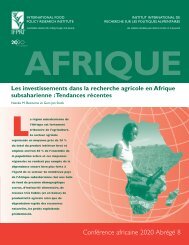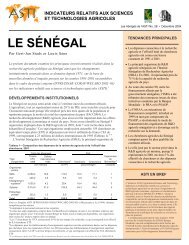Bangladesh country report - ASTI - cgiar
Bangladesh country report - ASTI - cgiar
Bangladesh country report - ASTI - cgiar
Create successful ePaper yourself
Turn your PDF publications into a flip-book with our unique Google optimized e-Paper software.
2010, Indian rice varieties covered 12 percent of planted rice area (Table 9). Farmers plant Indian varieties in all seasons,<br />
but especially in the late rainy season, when the short field duration of many Indian varieties gives farmers more options<br />
for the subsequent dry season crop. Estimating that the advantage farmers realize with Indian varieties is equivalent to<br />
one-tenth of the rental value of irrigated land in the dry season (circa 1 ton per hectare of clean rice, or US$442 per hectare<br />
in 2010), the additional net income from Indian rice varieties introduced through the informal private sector was US$59<br />
million in 2010.<br />
Jute<br />
Farmers and informal traders introduced jute cultivars from India, which are now widely grown in <strong>Bangladesh</strong>. Because the<br />
government has not registered any jute cultivars from India, seed companies have not been able to incorporate production<br />
and trade in such seeds into their normal business. In recent years, the Ministry of Agriculture has issued yearly permissions<br />
allowing specific companies to import Indian jute seeds on a year-by-year basis.<br />
Vegetables and Poultry<br />
Increases in GDP per capita (see above) boost demand for high-value foods. The <strong>Bangladesh</strong> Bureau of Statistics (BBS)<br />
<strong>report</strong>s large increases in per capita consumption of animal protein, fruits, and vegetables from 1998/99 to 2004/05 (Table<br />
8). According to the 2005 HIES (BBS 2007), middle-income people in rural areas spent 17 percentof their incomes on fish,<br />
meat, milk, fruits, and vegetables compared with 25 percent on rice. Private organizations introduce most technology—<br />
poultry breeds and feeds, vegetable cultivars—for high-value foods. As of 2001, poultry provided an estimated 78<br />
percentof the meat produced in <strong>Bangladesh</strong> (Quasem 2003).<br />
Table 8. Per capita yearly consumption of selected agricultural products, 1998–2005<br />
Product 1998–99 1999–2000 2000–01 2001–02 2002–03 2003–04 2004–05<br />
Yearly growth for<br />
the period (%)<br />
Meat, kilograms 5.1 5.2 5.3 6.6 6.9 7.4 8.5 9<br />
Eggs, number 31 32 34 34 52 59 59 11<br />
Milk and milk products, liters 3.2 3.5 7.2 7.0 6.9 6.7 7.9 16<br />
Fish, kilograms 12.3 13.3 14.4 14.5 14.3 15.5 16.3 5<br />
Brinjal, kilograms 3.1 2.9 2.8 2.8 2.6 2.5 2.4


